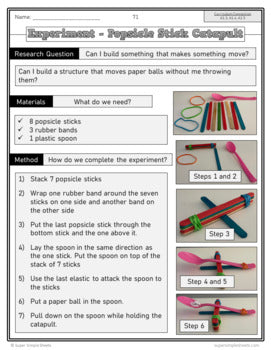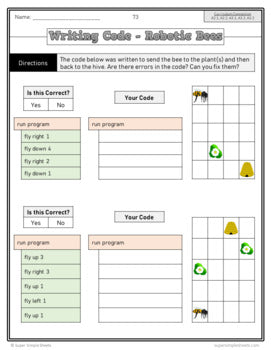NEW UPDATED 2022! - Ontario Grade 3 Science - Full Year Bundle - GOOGLE/PDF
NEW UPDATED 2022! - Ontario Grade 3 Science - Full Year Bundle - GOOGLE/PDF
Interested in a bundle? Shop below instead!
Couldn't load pickup availability
PRODUCT PREVIEW
NEWLY UPDATED IN 2022! BOTH GOOGLE AND PDF VERSIONS INCLUDED!
FULL YEAR BUNDLE! 380+ worksheets and your entire science year planned! This bundle covers all expectations New Ontario 2022 Science Curriculum - Grade 3.
These massive units contains readings, diagrams, experiments, true/false, and much more!
Most importantly, we have made cross-curriculum connections to the grade 3 language program. Students will practice reading comprehension strategies (making connections, questioning, visualizing, and inferencing) as they work through this unit.
Check out the previews of these units to learn more about how it can benefit your students. We know you will love this no-prep, just print or upload to Google, time-saving resource!
Unit 1 - Growth and Changes in Plants
Some of the concepts that are covered:
- Basic needs of plants – light, water, air, space, and warmth
- Parts of a plant – diagram
- Parts of a plant – readings and activities for each part (roots, stem, leaves, flower, and seeds)
- Life cycle of seed plants and bulb plants
- Experiment – germinating seeds in the classroom
- How seeds are spread – animals and the wind
- Parts of a flower – diagram
- Differences between plants
- Adapting plants – cactus
- Photosynthesis – Plants need the sun
- Lab Experiment – water travels through a plant
- Animals need the sun
- How we use plants – food, medicine, shelter, clothing
- How indigenous groups use plant
- Relationship between plants and animals - how plants need animals, and how animals need plants
- Analyzing pictures – animal and plant relationships
- How food is grown – greenhouses, farms, and home gardens
- Locally grown food – Farmers’ Markets
- Organic food – use of pesticides in farming
- Environmental challenges to plants – drought, extreme cold, extreme heat, construction
- How humans can help plants
- 2-billion tree challenge – Canadian government
- Answer pages for all activities
Unit 2 - Strong and Stable Structures
Some of the concepts that are covered:
- What are structures?
- Human-made structures and natural structures
- Structures hold a load
- Live loads and dead loads
- Stability of structures
- Structures – form and function
- Describing the form and function of various structures
- Properties of materials – strength, flexibility, durability
- Strong building materials – steel versus plastic
- Describing materials based on their properties
- Creating stronger building materials – layering, braiding/twisting, and folding
- Science experiment – layering activity – testing building materials
- Science experiment – folding activity - testing building materials
- Fasteners – glue, nails, screws, paperclip, zipper, rope, tape, buttons and more
- Strong fasteners
- Centre of gravity affecting stability
- Leaning Tower of Pisa – centre of gravity
- Centre of gravity experiments
- Forces acting on structures – tension and compression
- Effects of forces on objects – breaking point
- Struts and ties – compression (struts) and ties (tension)
- Strong shapes – triangles and trusses (uses struts and ties)
- Experiment – Using triangles to build strong structures
- Safe structures – using structures properly
- Structures in my environment – examining the building materials and fasteners
- The Great Pyramid still standing – lessons learned from the 5,000-year-old structures
- Effects of shelters (structures) on the environment
- Unit test
- Answer pages for all activities
Unit 3 - Forces and Motion
Some of the concepts that are covered:
- Non-contact forces versus contact forces
- Forces – push and pull
- Gravity – readings, activities, and experiment
- Electrostatic force – readings and questions
- Static electricity – reading and questions
- Dangers of static electricity
- Lightning – electrostatic force
- Magnetic forces – reading, activities, experiment
- Devices that use non-contact forces – magnetism, electrostatic, and gravity
- Contact forces – muscular force, friction, and spring force
- Friction – sliding friction, static friction, and rolling friction
- Muscular force in sports
- Forces acting on objects
- Unbalanced and balanced forces causing change in direction
- Examples of unbalanced and balanced forces
- Objects changing direction – sports examples
- Force diagrams – showing change in direction
- Forces in our everyday lives
- Forces of nature – tsunami (water force) and tornado (wind force)
- Natural forces – erosion
- Clearcutting forests causing erosion – diagram
- Wearing protective gear to be safe around forces
- Unit test
- Answer pages for all activities
Unit 4 - Soils in the Environment
Some of the concepts that are covered:
- What is soil?
- Soil is alive – living organisms in soil
- What is in our soil?
- Layers of soil – diagram, reading, and questions
- Experiment – creating the layers of soil model
- Sandy soil - advantages and disadvantages
- Silt soil - advantages and disadvantages
- Clay soil - advantages and disadvantages
- Loam soil - advantages and disadvantages
- Water in soil
- Investigating components in soil – experiment/activity
- Plant profiles – Types of soils that different plants like
- Cactus plant profile – surviving in sandy soil
- Additives in soil – fertilizers and pesticides
- Pesticides – organic versus chemical
- Organic versus non-organic food
- Composting – reading, questions, and experiment/activity
- Manure – natural fertilizer
- Improving soil – crop rotation
- Different uses of soil – shelters (soddies, adobe, clay pots)
- Importance of soil for living things
- Erosion – moving soil with water and wind
- Weathering rocks – formation of soil
- Weathering, erosion, and deposition – changing our land
- Controlling soil erosion – Windbreaks, terracing, and reforestation
- Unit test
- Answer pages for all activities
*** Answer Pages for all worksheets
*** Unit Tests for all Units
Share





I have used this for my high school special education class. Easy to use. Well laid out. Everything you need to learn about plants.
Filled with so many activities that make teaching easier and organized b
Good Resource!
Excellent material. It covers all the topics








